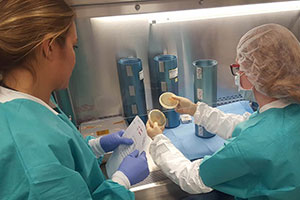The mission, BRIC-NP (Biological Research in a Canister – Natural Products), will screen several species of fungi isolated from the area near the Chernobyl nuclear power plant disaster to see if they can produce novel compounds that could be beneficial for pharmacological or agricultural purposes.
Researchers are looking to see if the stresses of microgravity and radiation in the International Space Station environment will prompt the specimens to produce new natural products. “Microorganisms only make certain things when they need to,” USC School of Pharmacy professor Clay C.C. Wang told Popular Science. “We want to see if they actually make new compounds in space.”
The experiment launched successfully on Monday, July 18 aboard a Falcon 9 rocket from Cape Canaveral Air Force Station in Florida, and docked at the International Space Station on Wednesday, July 20.

Of the eight different species of fungi sent to the International Space Station, two of the species (Cladosporium sphaerospermum and Cladosporium cladosporioides) are radiotrophic and use radiation as an energy source. The other six species were selected for their ability to produce compounds that could be used for medicinal and agricultural purposes.
BRIC-NP team members are Dr. Kasthuri Venkatswaran at Jet Propulsion Laboratories, Caltech (PI); Clay C.C. Wang, PhD at USC School of Pharmacy (coI); Dr. Tamas Torok at Lawrence Berkeley National Lab (coI); graduate student Adriana Blachowicz at USC School of Pharmacy; graduate student Jillian Romsdahl at USC School of Pharmacy.
In Micro-10, another research project that launched to the International Space Station earlier this spring, Wang and colleagues examined the influence of microgravity on the production of Aspergillus secondary metabolites. It launched aboard a SpaceX resupply flight on Friday, April 8, and returned to earth in May.
Read more about the BRIC-NP mission in Popular Science.


